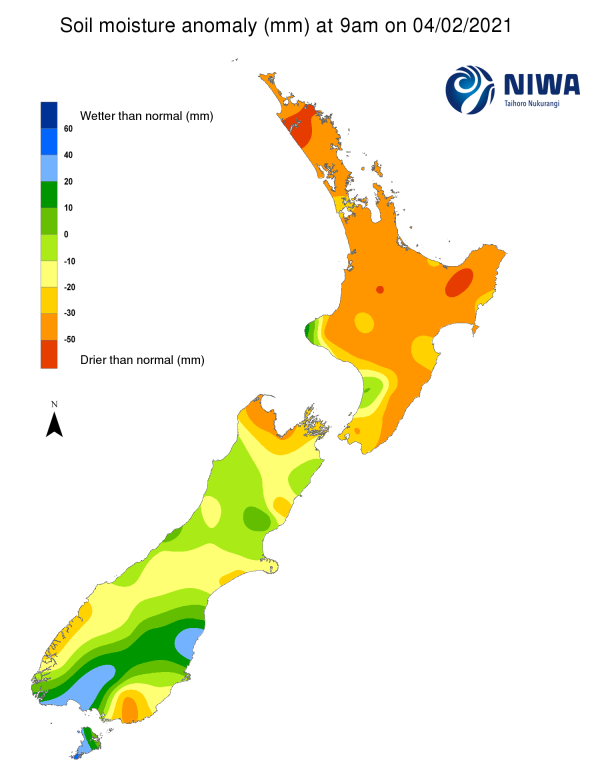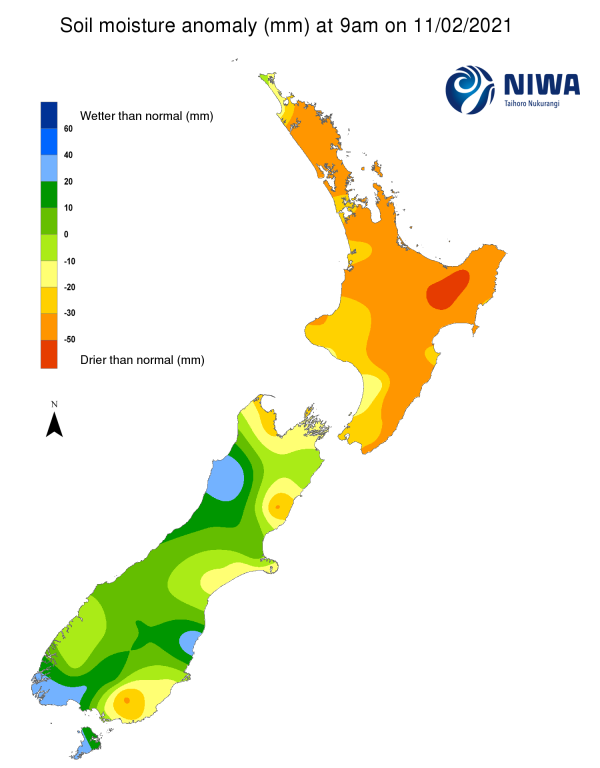A weekly update describing soil moisture patterns across the country to show where dry to extremely dry conditions are occurring or imminent. Regions experiencing significant soil moisture deficits are deemed “hotspots”. Persistent hotspot regions have the potential to develop into drought.
Facts: Soil Moisture
The upper and western North Island generally saw light-to-moderate rainfall during the past week, with many locations receiving 10-25 mm, and isolated locations receiving more than 30 mm. However, the eastern North Island only received meagre rainfall, generally less than 5 mm. Most locations in the North Island saw small soil moisture decreases in the past week, although moderate increases were observed in the Far North. The driest soils across the North Island, when compared to normal for this time of the year, are found in eastern Bay of Plenty.
Hotspot conditions remain widespread across the North Island, including most of Northland, Auckland, northern Waikato, and the east coast. Hotspots also cover much of Bay of Plenty, the Central Plateau, central Manawatū-Whanganui, coastal Taranaki and near Wellington City. The New Zealand Drought Index (NZDI) map below shows that meteorological drought and severe meteorological drought remain in place in the northern half of the Far North District as well as a portion of East Cape. Widespread dry-to-extremely dry soils are in place in the remainder of Northland, Auckland, northern Waikato, western Bay of Plenty, East Cape, and much of the eastern North Island.
In the South Island, heavy rain was observed along the West Coast and in Marlborough Sounds, where many locations saw more than 50 mm, and isolated amounts of 100 mm or more. Moderate amounts of 15-30 mm were observed from central Canterbury to Southland, while northern Canterbury and eastern Marlborough received only minimal rainfall. This rainfall resulted in small-to-moderate soil moisture increases for most areas, although minor decreases occurred in northern Canterbury. The driest soils in the South Island compared to normal for this time of year are located in Hurunui District and eastern Southland, while the wettest soils for this time of the year for the South Island are found in northern Otago, western Southland, and northern West Coast.
Hotspots are currently in place in small parts of northern Tasman and coastal Hurunui District. The New Zealand Drought Index (NZDI) map below shows that dry to very dry soils are found in the northeastern South Island.
Outlook and Soil Moisture
High pressure overhead will bring dry weather to the North Island during the upcoming weekend. However, the upper North Island will likely receive rainfall from a low pressure system on Monday and Tuesday (15-16 February). Amounts could exceed 30 mm in Northland, and up to 20 mm in Auckland. However, the central and lower North Island will likely see little if any rain from this event. Thereafter, a strong area of high pressure will return with dry weather for mid-to-late next week. Weekly rainfall totals in the central and lower North Island could be very minimal.
Due to the expected weekly rainfall, soil moisture increases will be possible in Northland and perhaps parts of Auckland in the next week. However, the central and lower North Island will likely observe additional soil moisture decreases due to meagre rainfall. While hotspots in the upper North Island may weaken at least marginally in the next week, those located elsewhere are likely to strengthen.
High pressure is expected to bring dry weather to the South Island this weekend, but a front will deliver light to moderate rain to the eastern South Island late Monday and Monday night (15 February). However, a strong area of high pressure will then bring dry weather through the remainder of the week. Weekly rainfall totals around 10 mm will be possible in the lower and eastern South Island, but little if any rain is likely in western and northern areas.
Minimal rainfall in the next week will likely result in widespread soil moisture decreases across the South Island, especially in western and northern areas. Current hotspots are likely to intensify, particularly the one in northern Tasman.
Background:
Hotspot Watch: a weekly advisory service for New Zealand media. It provides soil moisture and precipitation measurements around the country to help assess whether extremely dry conditions are imminent.
Soil moisture deficit: the amount of water needed to bring the soil moisture content back to field capacity, which is the maximum amount of water the soil can hold.
Soil moisture anomaly: the difference between the historical normal soil moisture deficit (or surplus) for a given time of year and actual soil moisture deficits.
Definitions: “Extremely” and “severely” dry soils are based on a combination of the current soil moisture status and the difference from normal soil moisture (see soil moisture maps)
Hotspot: A hotspot is declared if soils are "severely drier than normal" which occurs when Soil Moisture Deficit (SMD) is less than -110 mm AND the Soil Moisture Anomaly is less than -20 mm.
Pictured above: Soil Moisture Anomaly Maps, relative to this time of year. The maps show soil moisture anomaly for the past two weeks.
New Zealand Drought Index (NZDI)
As of 9 February, the New Zealand Drought Index (NZDI) map below shows that meteorological drought and severe meteorological drought remain in place in the northern half of the Far North District as well as a portion of East Cape. Widespread dry-to-extremely dry soils are in place in the remainder of Northland, Auckland, northern Waikato, western Bay of Plenty, East Cape, much of the eastern North Island, and northeastern South Island. Please note: some hotspots in the text above may not correspond with the NZDI map. This difference exists because the NZDI uses additional dryness indices, including one which integrates the rainfall deficit over the past 60 days. Changes are therefore slower to appear in the NZDI compared to soil moisture anomaly maps that are instantaneously updated.




